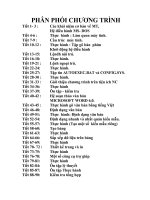Khái quát một tí về máy tiện ( tiếng anh )
Bạn đang xem bản rút gọn của tài liệu. Xem và tải ngay bản đầy đủ của tài liệu tại đây (1.39 MB, 17 trang )
Lathes and Lathe Operations
• Is considered to be the oldest machine tool
Lathe components
Bed
• supports all major components of the
lathe
• Large mass and made from gray or cast
iron
• Has two ways
• Many cross section
• A section of the bed in front of the
headstock can be removed
Carriage
• consists of the cross-slide, tool post and apron
Headstock
• is fixed to the bed
• is equipped with motors, pulleys and V-belts
Tailstock
• is equipped with a center which is
fixed =>> dead center
• Or is free to rotate with the work
piece itself =>> live center
• Drills and reamers can be mounted
on the tailstock quill to drill axial
holes
Feed rod and lead screw
• => rotates during the lathe operation =>> provides movement to the
carriage
Work-holding devices and
accessories
• Work-holding devices are important=> must hold the work piece
secure in place
A chuck
• Usually have three or four jaws
• Three-jaw chucks have gearedscroll design making the jaws selfcentering=> are used for round
work pieces
• Four-jaw chucks have jaws that can
be moved and adjusted
independently of each other=> can
be used for square, rectangular, or
odd-shaped work pieces
Power chucks
• with help of pneumatically or
hydraulically
A collet
• => work piece is placed inside the collet, and the collet is pulled
(draw-in collet) or pushed (push-out collet) mechanically into the
spindle
Face plates
Is round and have
several slots and
holes through which
the workpiece is
bolted or clamped
Mandrels
are used to hold workpieces that require
machining on both ends or on their
cylindrical surfaces.
Lathe operations
• Form tools
• Boring
• Drilling
Types of lathes
• Bench lathes
• Special-purpose lathes => railroad wheels, gun barrels, and rollingmill rolls
• Tracer Lathes => are capable of turning parts with various contours
• Automatic Lathes
• Automatic bar machines
• Turret lathes
• Computer-controlled Lathes
Turning-process Capabilities
• Production rates have an
important bearing on
productivity in machining
operations.
Guidelines for Turning
Operations
1. Minimize tool overhang
2. Support the workpiece rigidly
3. Use machine tools with high stiffness and high damping capacity
4. When tools begin to vibrate and chatter, modify one or more of the
process parameters









